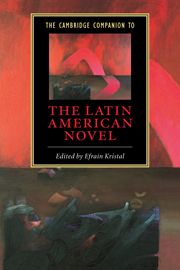4 - The Post-Boom novel
from Part I - History
Published online by Cambridge University Press: 28 May 2006
Summary
The New Novel in Latin America did not fade away with the end of the Boom, and there has been a rich and varied pattern of literary production in the region by both experienced and newer writers from the later 1960s up to the beginning of the twenty-first century. However, a perceived critical clarity about the nature of the Boom has not yet been matched by a similar sense of clarity about what came after it. Though there have indeed been many lively debates about the nature of the New Narrative and the Boom in Latin American fiction, there is now something approaching a broad consensus as to their chronology and characteristics. Such a consensus is more elusive when it comes to the rather more slippery category of the so-called Post-Boom, a term that has come to be used to refer to developments from the late 1960s and early 1970s onwards. Indeed, as late as 1990, a leading critic of the work of Argentina’s Manuel Puig (linked by many with the emergence of a Post-Boom) was complaining of the way in which “critics were quick to produce a new category…variously - and infelicitously - designated the 'petit-Boom', the 'Junior Boom', or even the 'post-Boom'.” However, the very currency of such terms does seem to indicate that some perceptible change of sorts was underway from around 1970, even if it was difficult to define clearly what that change really constituted. There are, for example, definite changes in material circumstances around this time which alert us to the possibility of a shift in emphasis. A number of major novelists associated with the Boom noticeably develop in a somewhat different direction during and after the seventies. And a cohort of new writers with a conspicuously different voice or agenda begin to publish around the turn of these key decades.
- Type
- Chapter
- Information
- The Cambridge Companion to the Latin American Novel , pp. 81 - 102Publisher: Cambridge University PressPrint publication year: 2005
- 4
- Cited by

